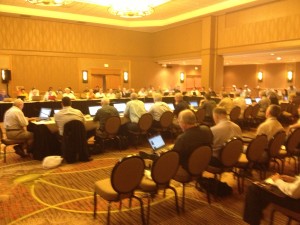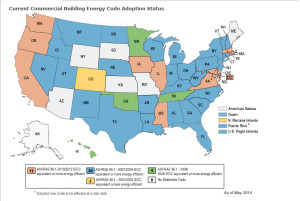meets at every ASHRAE meeting and when needed - as many as 4 times per year. The meeting typically last 4 days. We start on the Friday before before the ASHRAE meeting with a full day of subcommittee meetings. We
Monthly Archives: June 2014
Chapter 10 – Other Equipment
Chapter 10 Other Equipment is a catch-all chapter that has never been considered very important. That perception is changing as 90.1 attempts to reduce the “non-regulated” energy uses in buildings. Chapter 10 has always covered the requirements for electric motors. The minimum efficiency requirement tables for motors are located here and they are a good reference,. However, motor requirements are really set by the federal government and we are just adopting them here.
In 2010, we added section 10.4.2 Service Water Pressure Booster Systems which included requirements for the pumps that boost the domestic water from street pressure to the pressure required to serve the most remote plumbing fixture in the building. These pumps are not required for all buildings, but when city water pressure is not high enough, they must be installed. 90.1 requires these pumping systems to be either staged multiple pumps or variable speed to respond to pressure sensors installed near the most hydraulically remote fixture or control logic that accomplishes the same thing. The pumps must also be off when there is no demand for domestic water.
Also, in 2010, the first requirements for elevators were added. The elevator industry does not have a standard efficiency-testing program. We are encouraging them to develop a standard rating unit of measure so that we can set minimum standards. In the meantime, section 10.4.3 requires elevators to have a lighting efficacy of 35 lumins/watt. If ventilation fans are used, the power uses must not exceed 0.33 watts/cfm, and the lighting and fan must go off if the elevator is unoccupied with doors closed for more than 15 minutes.
In 2013, we added requirements for escalators and moving walkways in 10.4.4. The requirement is for them to slow to the minimum allowed speed when not conveying passengers. I saw these in Japan a couple of years ago. The things have sensors and speed up as you approach.
There are also new requirements for Whole-Building Energy Monitoring in 2013. These go along with the new requirements for sub-metering in the power section. So we would not be seen to be picking on electric energy, we are requiring whole building energy monitors for other fuels serving buildings or plants that serve new buildings. These fuels include natural gas, fuel oil, propane, steam, and chilled water. They must be measured at 1 hour intervals at a minimum. I think this is a little too much for a minimum standard since the gas is cheap right now and the gas use is normally for heat and hot water and can be broken out much more easily than the electric use. The requirement is for buildings over 25,000 sq. ft. or tenant spaces over 10,000 sq. ft. The monitored data must be stored for a minimum of 3 years, the same as the electric metering requirements. Metering is not required for fuels used in emergency power equipment.
As you apply the electric metering, sub-metering, and these requirements, I suggest that you use a common interval period. I use 15 minute data for my reports and, having everything at the same interval, including trended control points, makes parsing the data much easier. Be careful about collecting the data in too small intervals because you have to look at it for it to do you any good. You can always change the intervals if you are chasing a problem.
Opinions expressed here are solely my own and do not express the views or opinions of ASHRAE or the 90.1 committee.
Condensing Boilers
Since 90.1 sets the minimum requirements for energy use in buildings, it was decided that we would not require condensing boilers. Condensing boilers have special flue and condensate drain requirements that did not fit with the idea of “minimum requirements”. Since that decision was made, condensing boilers have become more and more common in buildings of all types.
In 90.1-2013 section, 7.5.3 was added. Section 7.5.3 Buildings with High-Capacity Building Service Water Heating Systems requires the total service water heating plant to have an input capacity weighted average thermal efficiency of at least 90%. This means that several boilers can be used with varying efficiencies, but the total Btuh output that heats the water divided by the total gas input in Btuh must be greater than 90%. This means that condensing boilers will be needed to meet this requirement.
The high capacity building service water heating system refers to systems with a total capacity of over 1,000,000 Btuh. This section has an effective date for compliance of July 2015. This date, after the Standard has been issued, allows the manufactures time to adjust their equipment designs and have testing done to meet the new requirements.
Since the efficiency of condensing boilers varies with return water temperatures. I personally would require the boiler to have 90% efficiency at the return water temperature as scheduled on the construction documents. This would require a return water temperature somewhere under 130°F.
Opinions expressed here are solely my own and do not express the views or opinions of ASHRAE or the 90.1 committee.
Surprising Chapter 8
 15 Minute Meter Data
15 Minute Meter Data
Chapter 8 Power is where we keep our latest surprises. In 2010, we added 8.4.2 Automatic Receptacle Control. This section requires 50% of the receptacles in offices and computer classrooms to be controlled by schedule or occupancy sensors. Therefore, when the space is not being occupied, 50% of the receptacles will be off. Printing and copy rooms, workstations, break rooms, and conference rooms were added in 2013. These controlled receptacles are required to be permanently marked visually.
In 2013, requirements for sub-metering were also added to Chapter 8. Section 8.4.3 Electric Energy Monitoring requires that the electrical energy for the whole building, HVAC, interior lighting, exterior lighting, and electrical outlets all be separately monitored and reported. The reporting has to be at a minimum every 15 minutes, hourly, daily, monthly, and annually. The data must be retained a minimum of 3 years. This requirement is for buildings over 25,000 sq. ft., tenant spaces over 10,000 sq. ft. and residential buildings with over 10,000 sq, ft, of common area.
Opinions expressed here are solely my own and do not express the views or opinions of ASHRAE or the 90.1 committee.
Enforcement
The 4th chapter of the Standard is Administration and Enforcement. The Standard applies to new buildings, building additions and alterations, replacement, and changes in space conditioning. Historic buildings are exempt. For additions and alterations, existing equipment can be repaired and reused without having to meet the current code requirements. When a space is being changed to a conditioned space, the envelope must be insulated, and any added lighting and equipment must meet the current standard. The enforcement section leaves many decisions in the hands of the authority having jurisdiction.
In 1992, the EPACT(Energy Policy Act) adopted ASHRAE 90.1 as the equivalent of the National Energy Code for commercial buildings. In reality, there is no “National Energy Code.” Building codes are adopted by states and local jurisdictions. The federal law requires the DOE to determine if a new addition of 90.1 would save energy. If the determination is made that the new standard would save energy, then federal buildings have one year to begin using the new standard and the states have two years to update their energy codes. The federal buildings must also, by law, exceed the standard by 30% where economically feasible. ASHRAE 90.1-2010 shows nearly a 30% improvement over the 2004 addition and to exceed the 2010 version by 30% will require an integrated design effort.
Federal buildings funded after September 9, 2013 must meet the requirements of 90.1-2010. The clock is running for the states to adopt the new standard. The map below shows the current State Energy Code adoption.
Some states are behind in adopting the energy code. The DOE is working to help these states adopt the current energy code. The 90.1-2013 code is now going through the adoption process. On May 15, 2014 the DOE made a preliminary determination and opened a period for comment until June 16, 2014. The DOE determined that the 2013 addition would save 8.5% and should be adopted as the new energy code.
Opinions expressed here are solely my own and do not express the views or opinions of ASHRAE or the 90.1 committee.
Chapter 3
The definitions are found in Chapter 3 of the Standard. If a word in the text is in italics, it can be found in Chapter 3. It is very important to look at the definitions. The information in Chapter 3 can clarify the meaning of the section you are interpreting.
The definitions contain all of the information needed for calculating the day-lighting areas required in the envelope and lighting section. The top-lighted area and side-lighted area calculations are explained with diagrams.
Opinions expressed here are solely my own and do not express the views or opinions of ASHRAE or the 90.1 committee.

